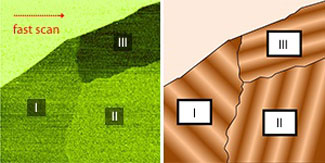| Nov 21, 2011 |
Surprise domains observed in graphene
|
|
(Nanowerk News) Seven years after graphene was first isolated as single sheets by mechanical exfoliation, the method remains the preferred approach to obtaining high-quality crystals with high electron mobility. However, due to defects in the crystal lattice, the mobilities so far obtained experimentally fall far below the theoretical ideal. Jeong Young Park and colleagues from KAIST, Konkuk University and other institutions in Korea and the US have now identified a domain structure in exfoliated graphene that could contribute to such mobility degradation ("Friction Anisotropy–Driven Domain Imaging on Exfoliated Monolayer Graphene").
|
|
Mobility in graphene is impeded by various types of defects, including atomic defects, impurities, and ripples and wrinkles in the crystal lattice. One type of mobility-reducing defect that has never been observed so far in exfoliated graphene, however, is the boundary between contiguous lattice domains.
|
 |
| Friction force microscopy image (left) showing domains in graphene (left), each with a different friction ripple orientation (right). (© 2011 AAAS)
|
|
Domain boundaries are known to occur in graphene grown by chemical vapor deposition, and the domains of slightly different lattice orientations can be readily observed by atomic force microscopy. Sheets of monolayer graphene obtained by exfoliation, on the other hand, seem perfectly, atomically homogeneous. Using a modified scanning atomic probe technique called friction force microscopy, however, Park and his colleagues clearly observed a distinct domain structure defined by friction characteristics, with each domain being a few micrometers wide.
|
|
Not only did the researchers observe variations in friction from one domain to the next (see image), they also found that within each domain the friction varies periodically with the relative orientation of the sample and the scanning direction of the microscope tip. For the researchers, the most convincing explanation of this observation is the formation of ripples due to strain when the graphene is deposited on the silica substrate for imaging. When the probe tip is scanned perpendicular to the ripple orientation, the friction is higher due to bending of the ripples. On scanning parallel to the ripples, no such bending occurs and the friction is lower.
|
|
The discovery of domains in exfoliated graphene and the knowledge that they affect friction properties are expected to have practical consequences. "Friction mapping is a powerful tool for studying the domain structures in graphene," says Park, "which are a crucial issue in graphene-based electronics."
|

